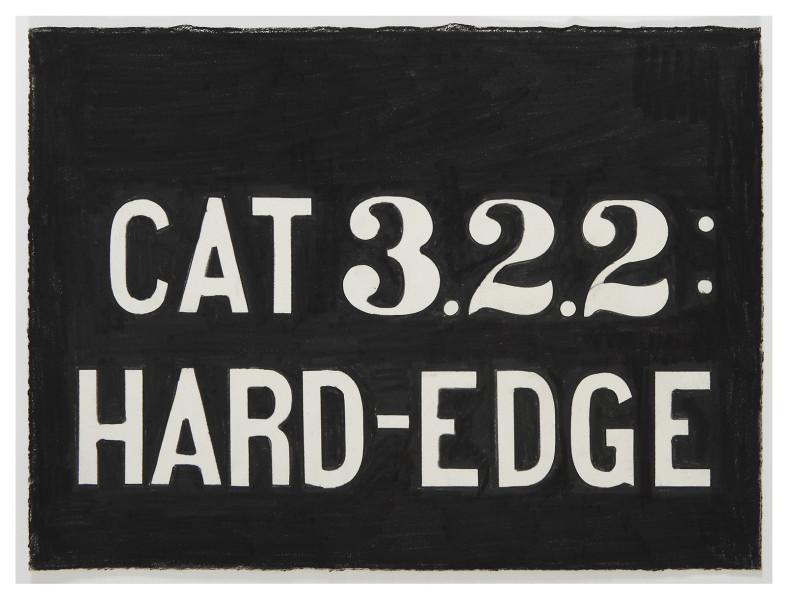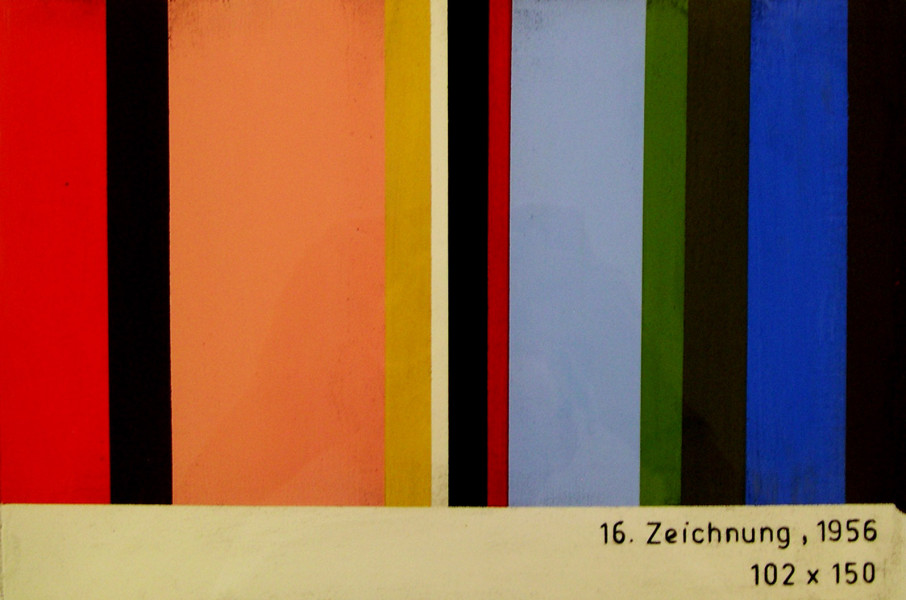Post
Marcel van Eeden è nato a L’Aia (Olanda) nel 1965; attualmente vive e lavora a Zurigo. I suoi lavori fanno parte di importanti collezioni pubbliche e private, tra cui: Kupferstichkabinett, Berlino; Stedelijk Museum, Amsterdam; The Museum of Modern Art (MOMA), New York; Centre Pompidou, Parigi; Walker Art Center di Minneapolis; ABN AMRO Kunststichting, Amsterdam; Baloise Group Art Collection, Basilea. I suoi lavori sono stati esposti in importanti istituzioni internazionali e tra le mostre più recenti vi sono: Martin-Gropius-Bau di Berlino (G: 2015, 2012, 2011); Centre Pompidou (S: 2013); GEM Museum de L’Aia (S: 2014, 2013); Tel Aviv Museum of Modern Art (S: 2014); Museo de Arte del Banco de la República di Bogotá (G: 2014); Tate St. Ives, Nottingham (G: 2013); Museum of Contemporary Art, Calgary (S: 2012); Institut Mathildenhöhe di Darmstadt e Kunstmuseum St. Gallen di San Gallo (S: 2011); Museo Stedelijk di Schiedam (G: 2011); Museo Nacional de Arte Visuales di Montevideo (G: 2011); CGAC Santiago de Compostela (G: 2010, 2007); BAWAG Contemporary BAWAG Foundation di Vienna e Art Forum Baloise di Basilea (S: 2010); Hamburger Kunsthalle di Amburgo (S: 2009); MoMA di New York (G: 2009); Kupferstichkabinett, Berlino (G: 2008); Stedelijk Museum, Amsterdam (G: 2007). Nel 2006 ha partecipato alla IV^ Biennale di Berlino per l’Arte Contemporanea curata da Maurizio Cattelan, Massimiliano Gioni e Ali Subotnick e nel 2011 ha vinto il premio per il disegno della Daniel & Florence Guerlain Foundation for Contemporary Art. Le opere di Marcel van Eeden sono riproduzioni di illustrazioni pubblicate tra i primi anni del 1900 e il 1965 in vecchi libri, giornali, periodici; alcuni ritraggono persone, avvenimenti, spezzoni di film, opere d’arte. L’unica caratteristica comune a tutti i molteplici soggetti è il fatto di appartenere ad un’epoca antecedente al 1965, cioè alla nascita dell’artista stesso. A partire dal 1993 fino ai primi anni del 2000, van Eeden ha prodotto almeno un disegno al giorno, impegnandosi in un esercizio al contempo tecnico e narrativo, in cui l’indagine sul medium si accompagna ad una riflessione sulle effettive capacità dell’arte di raccontare la realtà. In entrambi i casi la temporalità costituisce l’elemento chiave per capire la sua ricerca, che corre lungo la scansione “passato – presente – futuro”. L’artista rinuncia a raccontare il presente e si concentra sulla riproposizione di fatti, storie e personaggi appartenenti ad un’epoca di cui lui ha una conoscenza solo mediata. Di quest’epoca, che non è né troppo remota, né davvero conosciuta, l’artista ripesca personaggi marginali a cui riscrive una storia che non è mai avvenuta, ma che sarebbe potuta avvenire, in cui accadimenti più o meno significativi entrano tutti con la stessa importanza. Per molti aspetti le sue opere ricordano i Date Paintings di On Kawara e le serie di numeri di Roman Opalka (come questi, anche le opere di van Eeden sono realizzate cominciando dall’angolo in alto a sinistra fino all’angolo in basso a destra), a partire dai quali l’artista opera una ricerca a ritroso, o forse, complementare, che si concretizza nella produzione di immagini né vere né false, ma verosimili, in cui realtà e realismo si confondono, in cui non c’è distinzione tra dettagli e fatti cruciali e in cui vige un ordine di cose dettato dalla pura contingenza. Questa concettualizzazione di fondo continua a permanere, nonostante la pratica artistica di van Eeden si sia evoluta e abbia segnato un passaggio dal disegno alla pittura. Tale cambiamento da un lato consente all’artista un approccio più fisico alla realizzazione dell’opera, dall’altro modifica la relazione tra il pubblico e l’opera stessa, nella misura in cui disegni e dipinti si presentano allo spettatore come oggetti diversi che presentano caratteri linguistici diversi. Centrali restano il rigore tecnico e il ricorso puro a media tradizionali, una scelta specifica sulla quale l’artista modula il rapporto intercorrente tra i propri lavori e la tradizione artistica antica, moderna e del Novecento contemporaneo.
Marcel Van Eeden was born in The Hague (Holland) in 1965; currently lives and works in Zurich. His works are part of important public and private collections such as Kupferstichkabinett, Berlin; Stedelijk Museum, Amsterdam; The Museum of Modern Art (MOMA), New York; Centre Pompidou, Paris; Walker Art Center of Minneapolis; ABN AMRO Kunststichting, Amsterdam; Baloise Group Art Collection in Basel. His works have been exhibited in many international institutions, among the more recent ones there are: the Martin-Gropius-Bau in Berlin (G: 2015, 2012, 2011); Centre Pompidou (S: 2013); the GEM Museum in The Hague (S: 2014, 2013); the Tel Aviv Museum of Modern Art (S: 2014); the Museo de Arte del Banco de la República de Bogotá (G: 2014); the Tate St. Ives, Nottingham (G: 2013); the Museum of Contemporary Art, Calgary (S: 2012); the Institut Mathildenhöhe di Darmstadt and the Kunstmuseum St. Gallen di San Gallo (S: 2011); the Stedelijk Museum in Schiedam (G: 2011); the Museo Nacional de Arte Visuales de Montevideo (G: 2011); the CGAC Santiago de Compostela (G: 2010, 2007); the BAWAG Contemporary – BAWAG Foundation in Vienna and the Art Forum Baloise in Basel (S: 2010); the Hamburger Kunsthalle(S: 2009); the MoMA in New York (G: 2009); Kupferstichkabinett in Berlin (G: 2008), the Stedelijk Museum in Amsterdam (G: 2007). In 2006 he took part in the 4th Berlin Biennial of Contemporary Art curated by Maurizio Cattelan, Massimiliano Gioni and Ali Subotnick and in 2011 he won the Daniel & Florence Guerlain Foundation for Contemporary Art drawing prize. Marcel van Eeden’s works are reproductions of illustrations published from the early 20th Century to 1965, in old books, newspapers, magazines and they depict people, events, movie-clips, artworks. The only common characteristic of the different subjects is that they all belong to a time before 1965, the artist’s year of birth. Starting in 1993, until the early 2000’s, van Eeden had produced at least one drawing a day, engaging himself in an exercise both technical and narrative, in which the survey on the role of medium is accompanied by a reflection on the effective possibility for art to explain the reality. In both cases temporality is the key element to understand his research, that runs along the articulation “past – present – future”. The artist renounces to tell the present and focuses on reproposing facts, stories and characters belonging to a time that the he can only know undirectly. Of this past era, which is not too remote nor totally unknown, van Eeden digs out marginal characters and writes them a new story, that has never happened but that could have happened, in which important or unimportant events all enter with same relevance. For many aspects, van Eeden’s works remind On Kawara’s Date Paintings and the number series of Roman Opalka (and like these ones van Eeden’s works are realized beginning from the top-left corner ending in the bottom-right corner) and after them the Ducht artist elaborates a backward research -or maybe a complementary research- that materializes in the production of images neither true nor false, but plausibile. Reality and realism are reciprocally confused, there is no distinction between details and crucial facts and everything is ordered accordingly to pure contingency. This basic conceptualization is always kept, notwithstanding van Eeden’s artistic practice has evolved significantly, passing from drawing to painting. If this change from one side allows the artist to approach more physically the realization of a work, on the other it modifies the relationship between the audience and the artwork itself, for what drawings and paintings are seen as different objects with different linguistic characteristics. The technical rigour and the pure use of traditional media remain central, a specific choice on which the artist modulates the way in which his works relate to classic tradition and that inherited from Modern and Contemporary art.














